ECO mode TESLA MODEL S 2015 クイックガイド (in Japanese)
[x] Cancel search | Manufacturer: TESLA, Model Year: 2015, Model line: MODEL S, Model: TESLA MODEL S 2015Pages: 96, PDF Size: 2.86 MB
Page 29 of 96
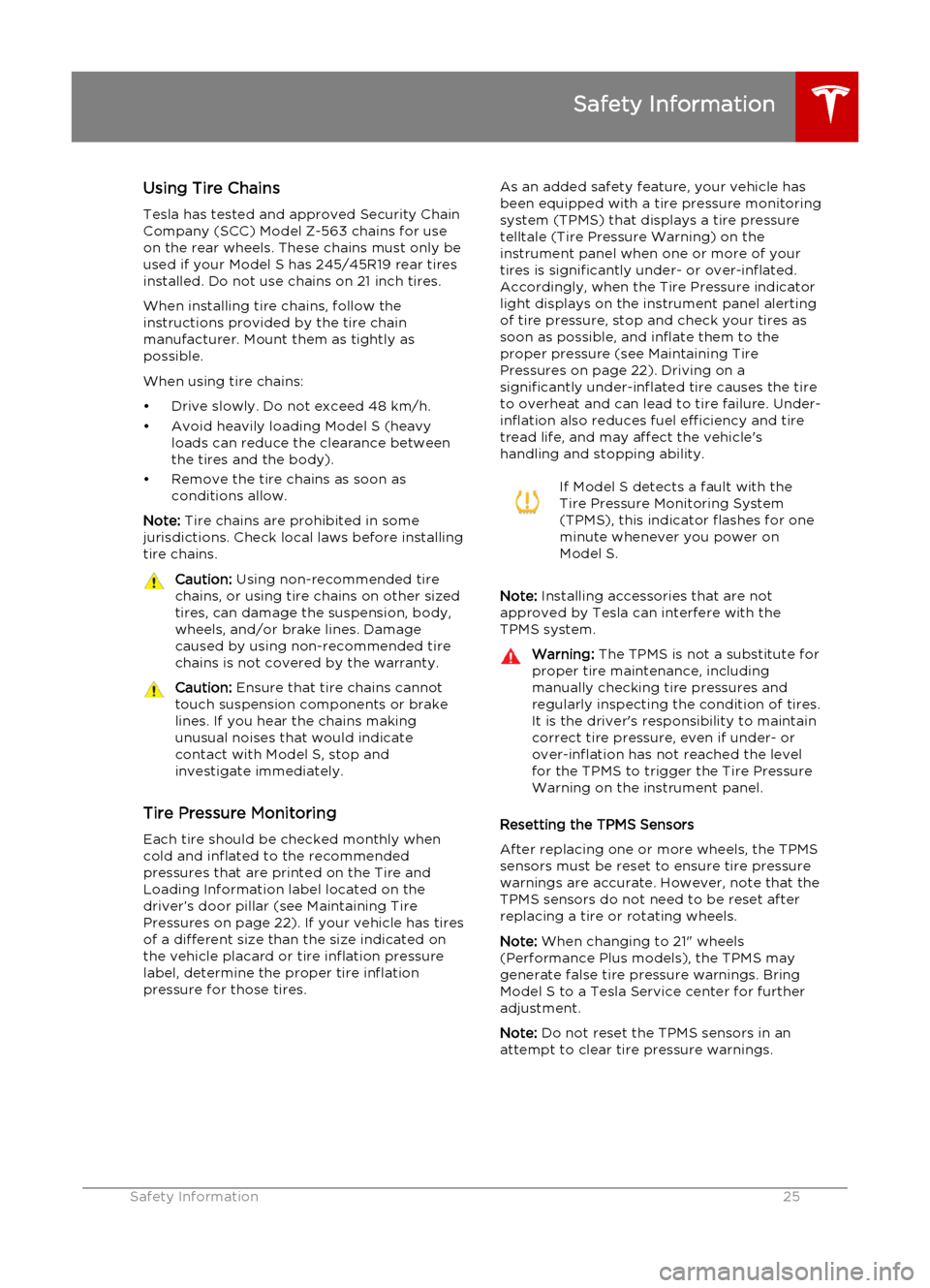
Using Tire ChainsTesla has tested and approved Security Chain
Company (SCC) Model Z-563 chains for use
on the rear wheels. These chains must only be
used if your Model S has 245/45R19 rear tires
installed. Do not use chains on 21 inch tires.
When installing tire chains, follow the
instructions provided by the tire chain
manufacturer. Mount them as tightly as
possible.
When using tire chains:
• Drive slowly. Do not exceed 48 km/h.
• Avoid heavily loading Model S (heavy loads can reduce the clearance betweenthe tires and the body).
• Remove the tire chains as soon as conditions allow.
Note: Tire chains are prohibited in some
jurisdictions. Check local laws before installing
tire chains.Caution: Using non-recommended tire
chains, or using tire chains on other sized tires, can damage the suspension, body,wheels, and/or brake lines. Damagecaused by using non-recommended tire
chains is not covered by the warranty.Caution: Ensure that tire chains cannot
touch suspension components or brake
lines. If you hear the chains making
unusual noises that would indicate
contact with Model S, stop and
investigate immediately.
Tire Pressure Monitoring
Each tire should be checked monthly when
cold and inflated to the recommended
pressures that are printed on the Tire and
Loading Information label located on the
driver’s door pillar (see Maintaining Tire Pressures on page 22). If your vehicle has tires
of a different size than the size indicated on
the vehicle placard or tire inflation pressure
label, determine the proper tire inflation
pressure for those tires.
As an added safety feature, your vehicle has
been equipped with a tire pressure monitoring system (TPMS) that displays a tire pressuretelltale (Tire Pressure Warning) on the
instrument panel when one or more of your
tires is significantly under- or over-inflated.
Accordingly, when the Tire Pressure indicator
light displays on the instrument panel alerting
of tire pressure, stop and check your tires as
soon as possible, and inflate them to the proper pressure (see Maintaining TirePressures on page 22). Driving on a
significantly under-inflated tire causes the tire
to overheat and can lead to tire failure. Under-
inflation also reduces fuel efficiency and tire
tread life, and may affect the vehicle's
handling and stopping ability.If Model S detects a fault with the
Tire Pressure Monitoring System
(TPMS), this indicator flashes for one
minute whenever you power on
Model S.
Note: Installing accessories that are not
approved by Tesla can interfere with the TPMS system.
Warning: The TPMS is not a substitute for
proper tire maintenance, including
manually checking tire pressures and
regularly inspecting the condition of tires.
It is the driver's responsibility to maintain
correct tire pressure, even if under- or
over-inflation has not reached the level
for the TPMS to trigger the Tire Pressure Warning on the instrument panel.
Resetting the TPMS Sensors
After replacing one or more wheels, the TPMS sensors must be reset to ensure tire pressurewarnings are accurate. However, note that theTPMS sensors do not need to be reset after
replacing a tire or rotating wheels.
Note: When changing to 21" wheels
(Performance Plus models), the TPMS may
generate false tire pressure warnings. Bring
Model S to a Tesla Service center for further
adjustment.
Note: Do not reset the TPMS sensors in an
attempt to clear tire pressure warnings.
Safety Information
Safety Information25
Page 30 of 96
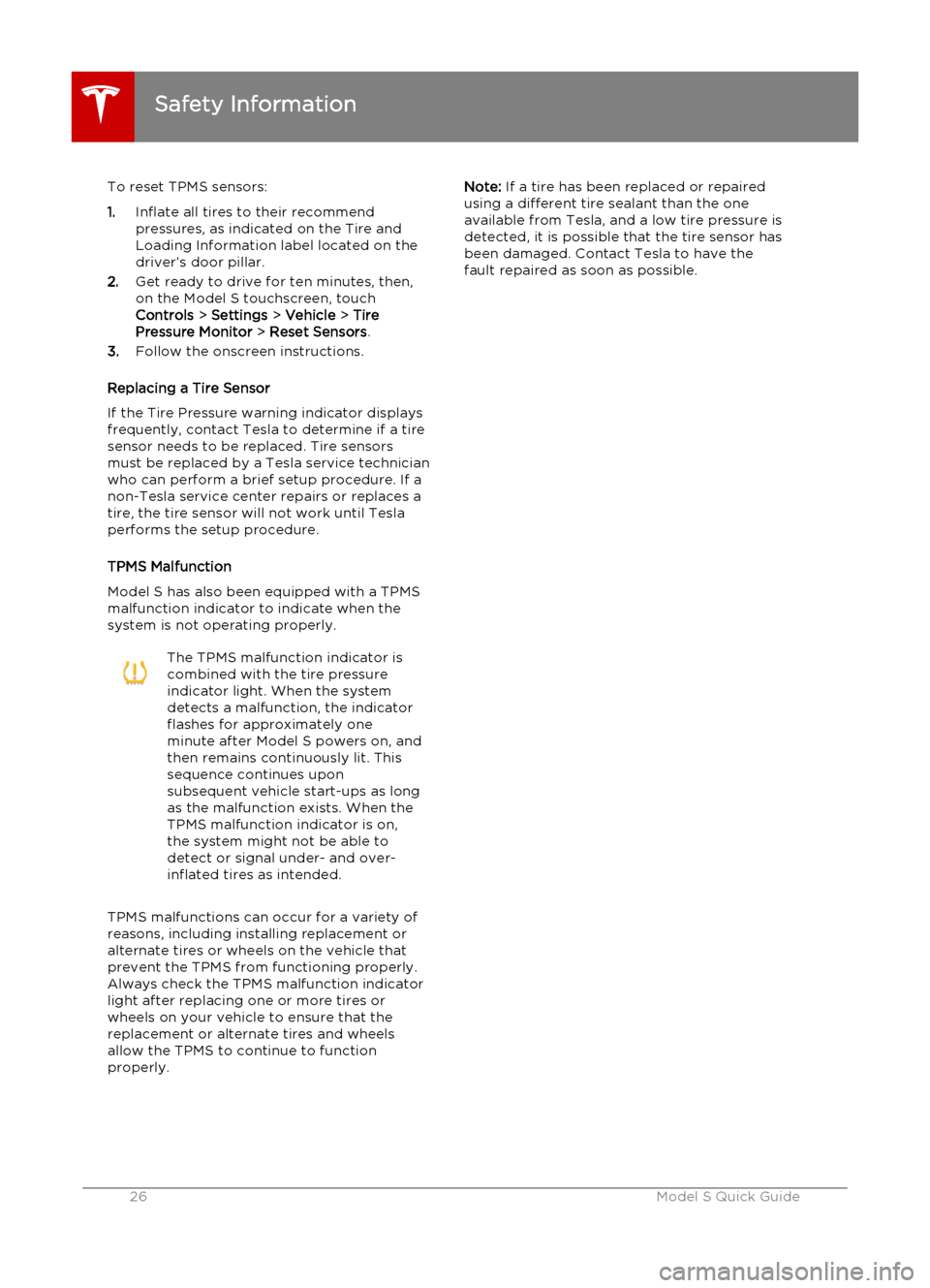
To reset TPMS sensors:
1. Inflate all tires to their recommend
pressures, as indicated on the Tire and
Loading Information label located on the
driver’s door pillar.
2. Get ready to drive for ten minutes, then,
on the Model S touchscreen, touch
Controls > Settings > Vehicle > Tire
Pressure Monitor > Reset Sensors .
3. Follow the onscreen instructions.
Replacing a Tire Sensor
If the Tire Pressure warning indicator displays
frequently, contact Tesla to determine if a tire
sensor needs to be replaced. Tire sensors
must be replaced by a Tesla service technician
who can perform a brief setup procedure. If a
non-Tesla service center repairs or replaces a
tire, the tire sensor will not work until Tesla
performs the setup procedure.
TPMS Malfunction
Model S has also been equipped with a TPMS
malfunction indicator to indicate when the
system is not operating properly.The TPMS malfunction indicator is
combined with the tire pressure
indicator light. When the system
detects a malfunction, the indicator
flashes for approximately one
minute after Model S powers on, and
then remains continuously lit. This
sequence continues upon
subsequent vehicle start-ups as long
as the malfunction exists. When the
TPMS malfunction indicator is on,
the system might not be able to
detect or signal under- and over-
inflated tires as intended.
TPMS malfunctions can occur for a variety of
reasons, including installing replacement oralternate tires or wheels on the vehicle thatprevent the TPMS from functioning properly.Always check the TPMS malfunction indicator
light after replacing one or more tires or
wheels on your vehicle to ensure that the replacement or alternate tires and wheels
allow the TPMS to continue to function
properly.
Note: If a tire has been replaced or repaired
using a different tire sealant than the one
available from Tesla, and a low tire pressure is
detected, it is possible that the tire sensor has
been damaged. Contact Tesla to have the
fault repaired as soon as possible.
Safety Information
26Model S Quick Guide
Page 33 of 96
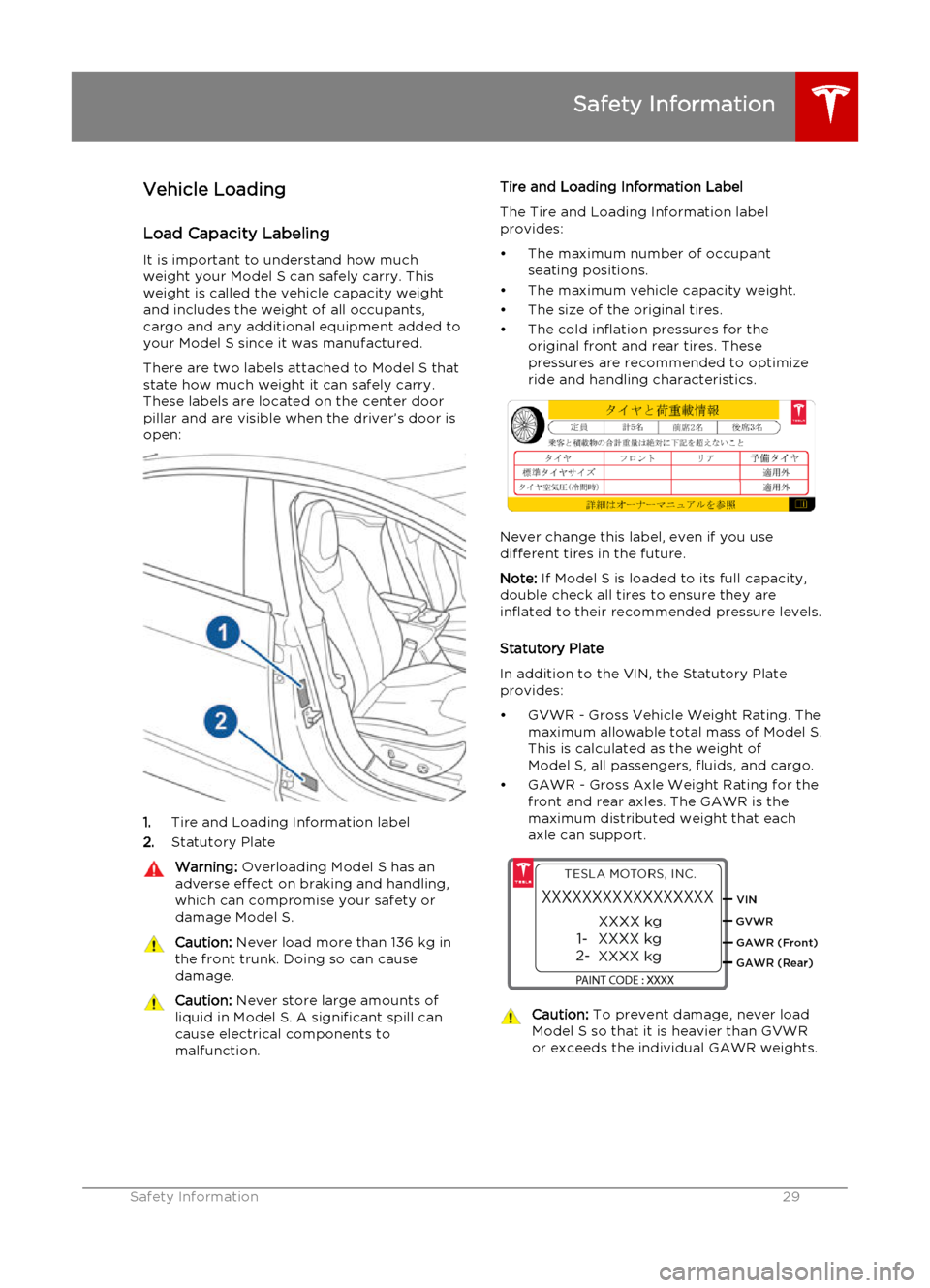
Vehicle Loading
Load Capacity Labeling It is important to understand how much
weight your Model S can safely carry. This weight is called the vehicle capacity weight
and includes the weight of all occupants, cargo and any additional equipment added toyour Model S since it was manufactured.
There are two labels attached to Model S that
state how much weight it can safely carry.
These labels are located on the center door
pillar and are visible when the driver’s door is
open:
1. Tire and Loading Information label
2. Statutory Plate
Warning:
Overloading Model S has an
adverse effect on braking and handling,
which can compromise your safety or
damage Model S.Caution: Never load more than 136 kg in
the front trunk. Doing so can cause
damage.Caution: Never store large amounts of
liquid in Model S. A significant spill can
cause electrical components to
malfunction.Tire and Loading Information Label
The Tire and Loading Information label provides:
• The maximum number of occupant seating positions.
• The maximum vehicle capacity weight.
• The size of the original tires.
• The cold inflation pressures for the original front and rear tires. These
pressures are recommended to optimize
ride and handling characteristics.
Never change this label, even if you use different tires in the future.
Note: If Model S is loaded to its full capacity,
double check all tires to ensure they are
inflated to their recommended pressure levels.
Statutory Plate
In addition to the VIN, the Statutory Plate provides:
• GVWR - Gross Vehicle Weight Rating. The maximum allowable total mass of Model S.
This is calculated as the weight of
Model S, all passengers, fluids, and cargo.
• GAWR - Gross Axle Weight Rating for the front and rear axles. The GAWR is the
maximum distributed weight that each
axle can support.
Caution: To prevent damage, never load
Model S so that it is heavier than GVWR
or exceeds the individual GAWR weights.
Safety Information
Safety Information29
Page 35 of 96
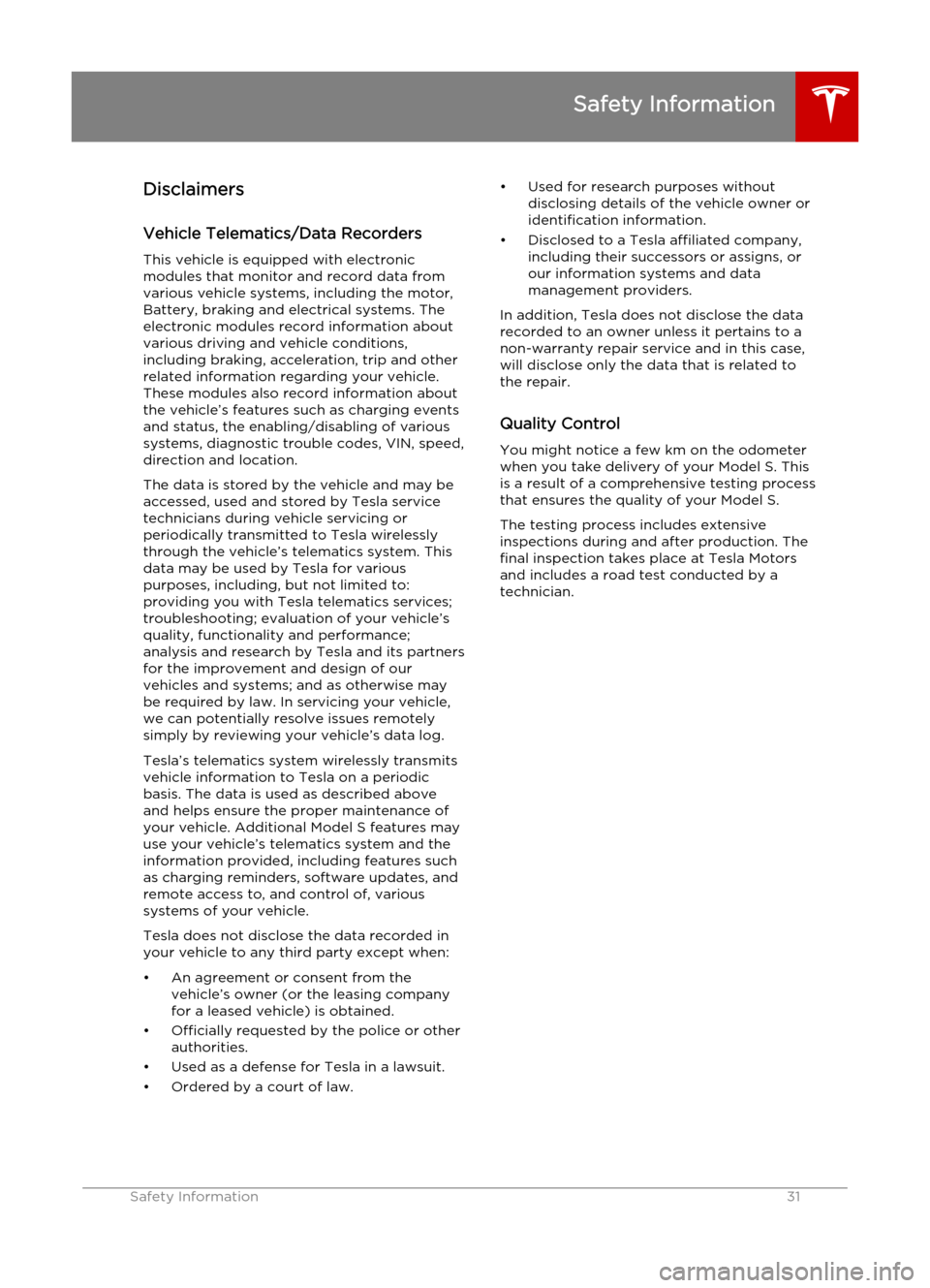
DisclaimersVehicle Telematics/Data RecordersThis vehicle is equipped with electronic
modules that monitor and record data from
various vehicle systems, including the motor,
Battery, braking and electrical systems. The
electronic modules record information about
various driving and vehicle conditions,
including braking, acceleration, trip and other
related information regarding your vehicle.
These modules also record information about
the vehicle’s features such as charging events
and status, the enabling/disabling of various
systems, diagnostic trouble codes, VIN, speed,
direction and location.
The data is stored by the vehicle and may be
accessed, used and stored by Tesla service
technicians during vehicle servicing or
periodically transmitted to Tesla wirelessly
through the vehicle’s telematics system. This
data may be used by Tesla for various
purposes, including, but not limited to:
providing you with Tesla telematics services;
troubleshooting; evaluation of your vehicle’s
quality, functionality and performance;
analysis and research by Tesla and its partners
for the improvement and design of our
vehicles and systems; and as otherwise may
be required by law. In servicing your vehicle,
we can potentially resolve issues remotely
simply by reviewing your vehicle’s data log.
Tesla’s telematics system wirelessly transmits
vehicle information to Tesla on a periodic
basis. The data is used as described above and helps ensure the proper maintenance of
your vehicle. Additional Model S features may
use your vehicle’s telematics system and the
information provided, including features such
as charging reminders, software updates, and
remote access to, and control of, various
systems of your vehicle.
Tesla does not disclose the data recorded in
your vehicle to any third party except when:
• An agreement or consent from the vehicle’s owner (or the leasing companyfor a leased vehicle) is obtained.
• Officially requested by the police or other authorities.
• Used as a defense for Tesla in a lawsuit. • Ordered by a court of law.• Used for research purposes without disclosing details of the vehicle owner or
identification information.
• Disclosed to a Tesla affiliated company, including their successors or assigns, or
our information systems and data
management providers.
In addition, Tesla does not disclose the data
recorded to an owner unless it pertains to a
non-warranty repair service and in this case,
will disclose only the data that is related to the repair.
Quality Control You might notice a few km on the odometer
when you take delivery of your Model S. This is a result of a comprehensive testing process
that ensures the quality of your Model S.
The testing process includes extensive
inspections during and after production. The final inspection takes place at Tesla Motors
and includes a road test conducted by a
technician.
Safety Information
Safety Information31
Page 42 of 96
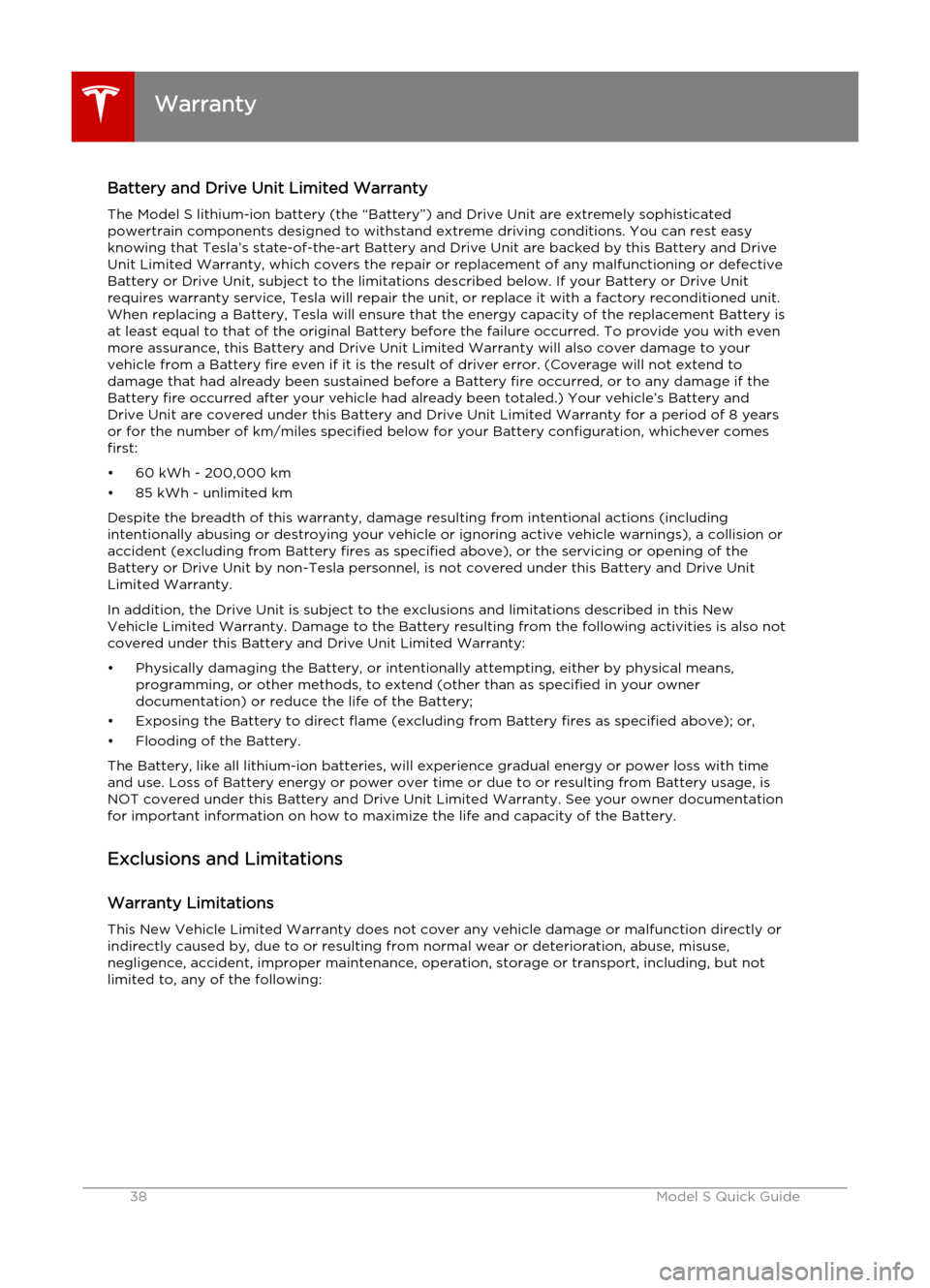
Battery and Drive Unit Limited WarrantyThe Model S lithium-ion battery (the “Battery”) and Drive Unit are extremely sophisticatedpowertrain components designed to withstand extreme driving conditions. You can rest easy
knowing that Tesla’s state-of-the-art Battery and Drive Unit are backed by this Battery and Drive
Unit Limited Warranty, which covers the repair or replacement of any malfunctioning or defective
Battery or Drive Unit, subject to the limitations described below. If your Battery or Drive Unit
requires warranty service, Tesla will repair the unit, or replace it with a factory reconditioned unit.
When replacing a Battery, Tesla will ensure that the energy capacity of the replacement Battery is
at least equal to that of the original Battery before the failure occurred. To provide you with even
more assurance, this Battery and Drive Unit Limited Warranty will also cover damage to your
vehicle from a Battery fire even if it is the result of driver error. (Coverage will not extend to
damage that had already been sustained before a Battery fire occurred, or to any damage if the
Battery fire occurred after your vehicle had already been totaled.) Your vehicle’s Battery and
Drive Unit are covered under this Battery and Drive Unit Limited Warranty for a period of 8 years or for the number of km/miles specified below for your Battery configuration, whichever comesfirst:
• 60 kWh - 200,000 km
• 85 kWh - unlimited km
Despite the breadth of this warranty, damage resulting from intentional actions (including intentionally abusing or destroying your vehicle or ignoring active vehicle warnings), a collision or accident (excluding from Battery fires as specified above), or the servicing or opening of the
Battery or Drive Unit by non-Tesla personnel, is not covered under this Battery and Drive Unit
Limited Warranty.
In addition, the Drive Unit is subject to the exclusions and limitations described in this New
Vehicle Limited Warranty. Damage to the Battery resulting from the following activities is also not covered under this Battery and Drive Unit Limited Warranty:
• Physically damaging the Battery, or intentionally attempting, either by physical means, programming, or other methods, to extend (other than as specified in your owner
documentation) or reduce the life of the Battery;
• Exposing the Battery to direct flame (excluding from Battery fires as specified above); or,
• Flooding of the Battery.
The Battery, like all lithium-ion batteries, will experience gradual energy or power loss with time and use. Loss of Battery energy or power over time or due to or resulting from Battery usage, is
NOT covered under this Battery and Drive Unit Limited Warranty. See your owner documentation for important information on how to maximize the life and capacity of the Battery.
Exclusions and Limitations
Warranty Limitations This New Vehicle Limited Warranty does not cover any vehicle damage or malfunction directly orindirectly caused by, due to or resulting from normal wear or deterioration, abuse, misuse,
negligence, accident, improper maintenance, operation, storage or transport, including, but not
limited to, any of the following:
Warranty
38Model S Quick Guide
Page 44 of 96
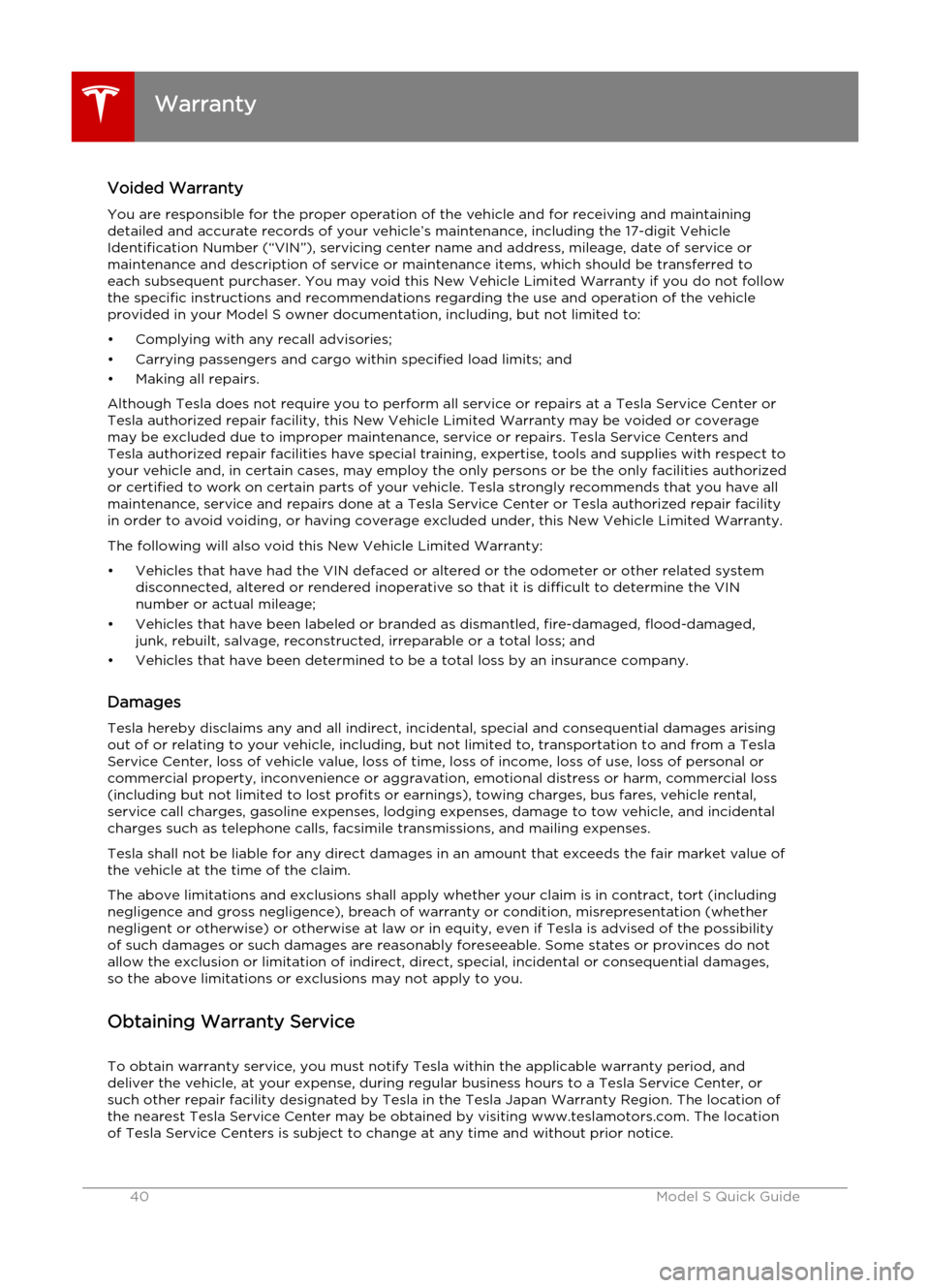
Voided Warranty
You are responsible for the proper operation of the vehicle and for receiving and maintaining detailed and accurate records of your vehicle’s maintenance, including the 17-digit Vehicle
Identification Number (“VIN”), servicing center name and address, mileage, date of service or
maintenance and description of service or maintenance items, which should be transferred to
each subsequent purchaser. You may void this New Vehicle Limited Warranty if you do not follow
the specific instructions and recommendations regarding the use and operation of the vehicle
provided in your Model S owner documentation, including, but not limited to:
• Complying with any recall advisories; • Carrying passengers and cargo within specified load limits; and• Making all repairs.
Although Tesla does not require you to perform all service or repairs at a Tesla Service Center or
Tesla authorized repair facility, this New Vehicle Limited Warranty may be voided or coverage
may be excluded due to improper maintenance, service or repairs. Tesla Service Centers and
Tesla authorized repair facilities have special training, expertise, tools and supplies with respect to
your vehicle and, in certain cases, may employ the only persons or be the only facilities authorized
or certified to work on certain parts of your vehicle. Tesla strongly recommends that you have all
maintenance, service and repairs done at a Tesla Service Center or Tesla authorized repair facility
in order to avoid voiding, or having coverage excluded under, this New Vehicle Limited Warranty.
The following will also void this New Vehicle Limited Warranty:
• Vehicles that have had the VIN defaced or altered or the odometer or other related system disconnected, altered or rendered inoperative so that it is difficult to determine the VINnumber or actual mileage;
• Vehicles that have been labeled or branded as dismantled, fire-damaged, flood-damaged, junk, rebuilt, salvage, reconstructed, irreparable or a total loss; and
• Vehicles that have been determined to be a total loss by an insurance company.
Damages Tesla hereby disclaims any and all indirect, incidental, special and consequential damages arisingout of or relating to your vehicle, including, but not limited to, transportation to and from a Tesla Service Center, loss of vehicle value, loss of time, loss of income, loss of use, loss of personal orcommercial property, inconvenience or aggravation, emotional distress or harm, commercial loss
(including but not limited to lost profits or earnings), towing charges, bus fares, vehicle rental,
service call charges, gasoline expenses, lodging expenses, damage to tow vehicle, and incidental
charges such as telephone calls, facsimile transmissions, and mailing expenses.
Tesla shall not be liable for any direct damages in an amount that exceeds the fair market value of
the vehicle at the time of the claim.
The above limitations and exclusions shall apply whether your claim is in contract, tort (including
negligence and gross negligence), breach of warranty or condition, misrepresentation (whether
negligent or otherwise) or otherwise at law or in equity, even if Tesla is advised of the possibility of such damages or such damages are reasonably foreseeable. Some states or provinces do not
allow the exclusion or limitation of indirect, direct, special, incidental or consequential damages,
so the above limitations or exclusions may not apply to you.
Obtaining Warranty Service To obtain warranty service, you must notify Tesla within the applicable warranty period, and
deliver the vehicle, at your expense, during regular business hours to a Tesla Service Center, or
such other repair facility designated by Tesla in the Tesla Japan Warranty Region. The location of the nearest Tesla Service Center may be obtained by visiting www.teslamotors.com. The location
of Tesla Service Centers is subject to change at any time and without prior notice.
Warranty
40Model S Quick Guide